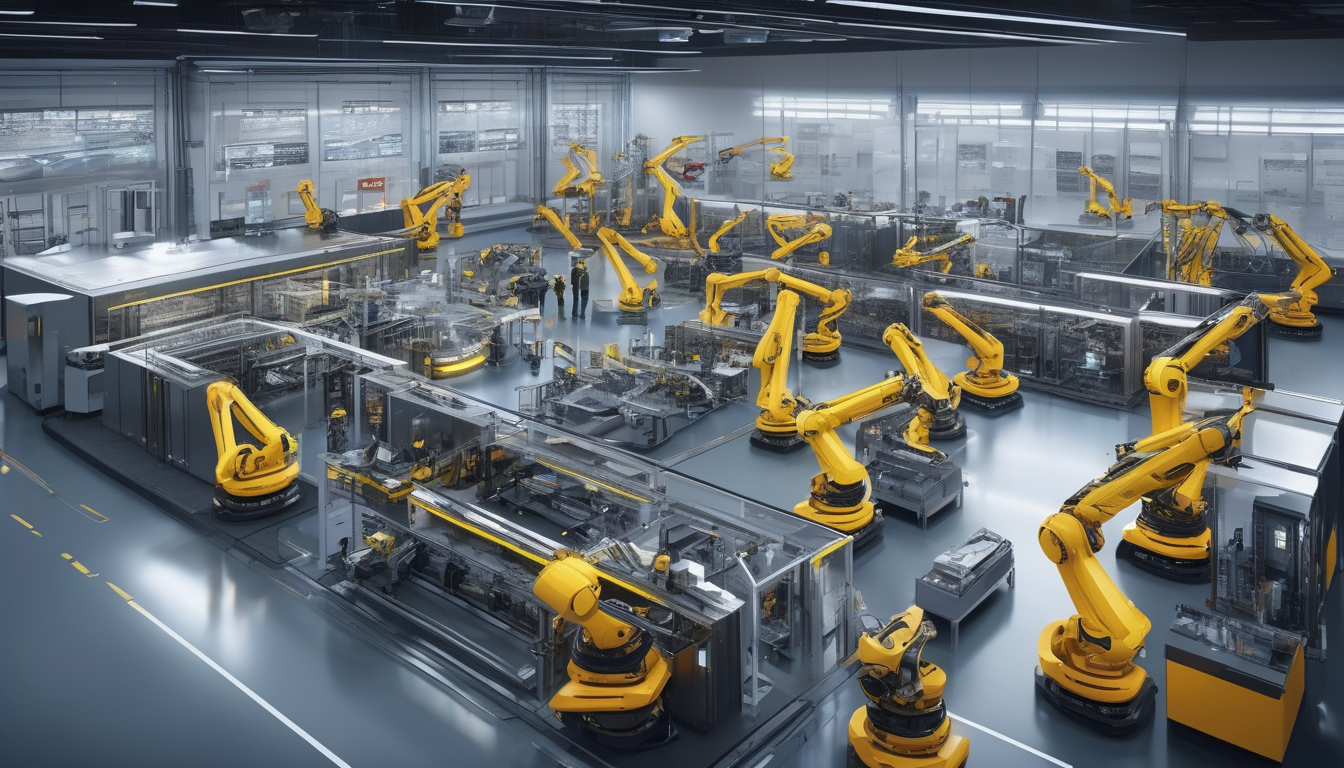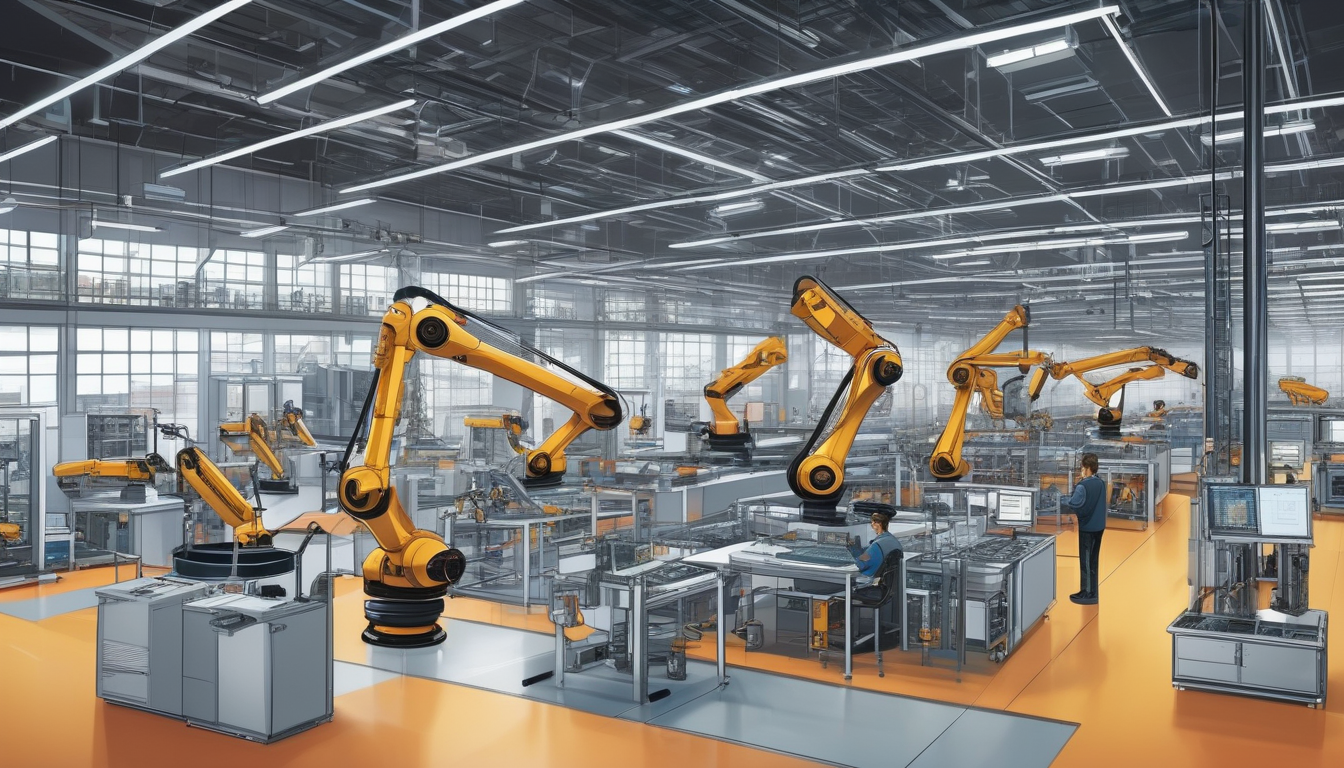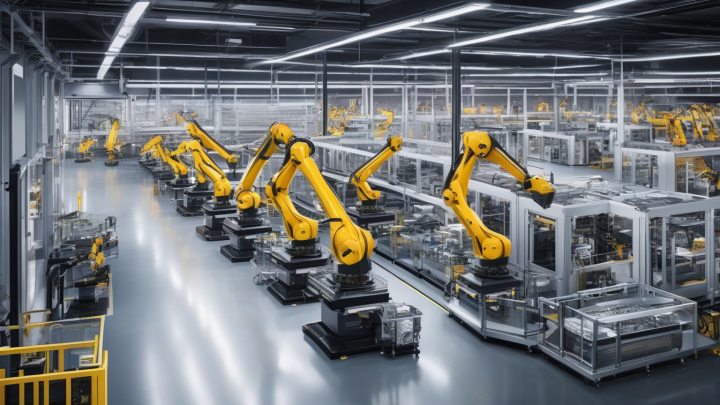In recent years, the manufacturing industry has experienced a remarkable transformation, largely driven by the integration of artificial intelligence (AI). This technology is not just a buzzword; it’s becoming the backbone of modern manufacturing processes. Imagine a factory floor where machines communicate seamlessly, predicting issues before they arise and optimizing production lines in real-time. Sounds futuristic, right? But it’s happening now!
AI in manufacturing encompasses a variety of applications that enhance operational efficiency and improve quality control. From automation to data analysis, AI is revolutionizing how manufacturers operate. For instance, AI systems can analyze vast amounts of data collected from production lines, helping managers make informed decisions quickly. This not only saves time but also reduces the likelihood of human error, which can be costly in a manufacturing environment.
Furthermore, the role of AI extends to decision-making processes, where it can provide insights that were previously unattainable. By leveraging machine learning algorithms, manufacturers can predict trends, adjust workflows, and even forecast demand with impressive accuracy. This predictive capability is crucial in today’s fast-paced market, where consumer preferences can shift overnight.
But what are the tangible benefits of integrating AI into manufacturing? Here are a few key advantages:
- Increased Productivity: AI can automate repetitive tasks, allowing human workers to focus on more complex activities.
- Reduced Operational Costs: By optimizing processes, AI helps in minimizing waste and lowering energy consumption.
- Improved Quality Control: AI technologies can detect defects in products much faster than the human eye, ensuring consistency and quality.
In summary, the integration of AI in manufacturing is not just enhancing efficiency; it is also setting new standards for quality control. As technology continues to evolve, manufacturers who embrace AI will likely find themselves ahead of the curve, ready to tackle the challenges of tomorrow.

Understanding AI in Manufacturing
Artificial Intelligence (AI) is reshaping the landscape of the manufacturing industry in ways that were once the stuff of science fiction. Imagine a factory floor where machines not only perform tasks but also learn from their environment and make decisions in real-time. This is the power of AI in manufacturing, and it’s making waves by enhancing operational efficiency and driving innovation.
At its core, AI involves the simulation of human intelligence processes by machines, particularly computer systems. In the manufacturing sector, AI applications are vast and varied, ranging from automation of repetitive tasks to sophisticated data analysis that informs strategic decisions. For instance, AI algorithms can analyze production data to identify patterns, predict outcomes, and optimize workflows. This capability allows manufacturers to stay ahead of the curve and respond swiftly to market demands.
One of the most significant roles of AI in manufacturing is its ability to facilitate automation. By integrating AI technologies, manufacturers can automate processes that were once labor-intensive. This not only speeds up production but also reduces the likelihood of human error, leading to higher quality products. Furthermore, AI can assist in decision-making processes by providing data-driven insights. For example, AI systems can evaluate the efficiency of different production methods and recommend the best approach, ensuring that resources are utilized effectively.
Moreover, the integration of AI into manufacturing isn’t just about enhancing existing processes; it’s about creating entirely new paradigms. As manufacturers adopt AI, they can develop smart factories that utilize interconnected devices and systems. These smart factories leverage the Internet of Things (IoT) to collect data from various sources, allowing for real-time monitoring and adjustments. The result? A more agile and responsive manufacturing environment that can adapt to changes swiftly.
In summary, understanding AI in manufacturing is crucial for businesses looking to thrive in a competitive landscape. By embracing AI technologies, manufacturers can not only improve efficiency but also set the stage for innovation and growth in the years to come.

The Benefits of AI Integration
Integrating artificial intelligence (AI) into manufacturing processes is like adding a turbocharger to an engine—suddenly, everything runs smoother and faster! The benefits of AI are not just theoretical; they manifest in real-world improvements that can transform how companies operate. From boosting productivity to slashing operational costs, AI is becoming the backbone of modern manufacturing.
One of the most striking advantages of AI integration is the increase in productivity. With AI systems handling repetitive tasks, human workers can focus on more complex and creative challenges. This not only enhances job satisfaction but also leads to better overall performance. Imagine a factory where machines work tirelessly, analyzing data and optimizing processes while humans innovate and strategize. It’s a win-win situation!
Moreover, AI significantly reduces operational costs. By automating processes and minimizing waste, manufacturers can save substantial amounts of money. For instance, AI can predict when machinery needs maintenance, preventing costly breakdowns that lead to downtime. This predictive maintenance is a game changer, allowing companies to allocate resources more effectively and avoid unnecessary expenses.
Another remarkable benefit is the improvement in quality control. AI technologies, such as machine learning and computer vision, are revolutionizing how products are inspected. These systems can detect defects at a level of precision that far surpasses human capabilities. The result? Higher quality products that meet or exceed customer expectations. In an industry where reputation is everything, this can be the difference between success and failure.
To sum it up, the integration of AI in manufacturing is not just a trend; it’s a necessity for companies looking to thrive in a competitive landscape. With enhanced productivity, reduced costs, and improved quality control, it’s clear that embracing AI is a step towards a more efficient and profitable future.
Predictive Maintenance
In today’s fast-paced manufacturing world, is not just a luxury; it’s a necessity. Imagine a scenario where your machines could talk, alerting you before they break down. Sounds like science fiction? Well, thanks to artificial intelligence, this is now a reality. By leveraging AI algorithms, manufacturers can analyze data from equipment sensors to predict when a machine is likely to fail. This proactive approach minimizes unexpected downtime and significantly reduces maintenance costs.
The beauty of predictive maintenance lies in its ability to transform reactive strategies into proactive ones. Instead of waiting for a machine to fail and then scrambling to fix it, manufacturers can schedule maintenance during non-peak hours. This leads to a smoother production process and ensures that operations run like a well-oiled machine. In fact, studies show that businesses implementing predictive maintenance can reduce maintenance costs by up to 30% and improve overall equipment effectiveness by 10-20%.
To illustrate the impact of predictive maintenance, consider the following table that outlines key benefits:
| Benefit | Description |
|---|---|
| Reduced Downtime | Anticipating failures allows for timely interventions, keeping production lines running smoothly. |
| Cost Savings | Less unplanned downtime translates to lower operational costs and increased profitability. |
| Extended Equipment Lifespan | Regular maintenance based on predictive analytics helps in prolonging the life of machinery. |
Moreover, the integration of AI in predictive maintenance not only enhances efficiency but also improves safety. By identifying potential equipment failures before they occur, manufacturers can prevent hazardous situations that could endanger workers. In essence, predictive maintenance is a game-changer, driving the manufacturing sector towards a more efficient and safer future. So, are you ready to embrace this technological revolution?
Data Analytics for Performance Improvement
In today’s fast-paced manufacturing landscape, data analytics has become the backbone of performance improvement strategies. Imagine having a crystal ball that not only shows you what’s happening on the factory floor but also predicts what might happen next. That’s the power of AI-driven data analytics! By leveraging vast amounts of data generated during production, manufacturers can identify inefficiencies and streamline processes like never before.
For instance, consider a scenario where a factory is experiencing frequent delays. With AI analytics, data from various machines and processes can be analyzed to pinpoint the root cause of these delays. Is it a bottleneck in the assembly line? Or perhaps a specific machine is underperforming? By answering these questions, manufacturers can implement targeted solutions, leading to significant productivity gains and reduced waste.
Moreover, data analytics allows for real-time adjustments. When production data is continuously monitored, manufacturers can react swiftly to any anomalies. For example, if a particular product line shows signs of quality issues, the system can alert operators immediately, allowing them to take corrective action before the problem escalates. This not only improves the quality of the end products but also enhances customer satisfaction.
To illustrate the impact of data analytics, consider the following table that outlines key benefits:
| Benefit | Description |
|---|---|
| Increased Efficiency | Identifies bottlenecks and optimizes workflows. |
| Cost Reduction | Minimizes waste and lowers operational costs. |
| Enhanced Decision Making | Provides insights for informed strategic planning. |
| Improved Quality | Ensures consistency and reduces defect rates. |
In conclusion, the integration of data analytics in manufacturing is not just a trend; it’s a necessity for those looking to stay competitive. By harnessing the power of data, manufacturers can unlock new levels of efficiency and quality, ensuring they not only meet but exceed customer expectations.
Real-time Monitoring Systems
In today’s fast-paced manufacturing environment, have become the backbone of operational success. Imagine having an eagle’s eye view of your entire production process, where every machine, every component, and every workflow is constantly under surveillance. This level of oversight allows manufacturers to detect issues before they escalate, ensuring that production runs smoothly and efficiently.
These systems utilize artificial intelligence to gather and analyze data from various sources, providing valuable insights into the manufacturing process. By employing sensors and IoT (Internet of Things) devices, real-time monitoring systems can track everything from machine performance to environmental conditions. This data is then processed to generate actionable insights, allowing managers to make informed decisions on the fly.
One of the standout features of these systems is their ability to alert operators to potential problems, such as machinery malfunctions or deviations from quality standards. For instance, if a machine is operating outside its normal parameters, the system can send an instant notification to the maintenance team, allowing them to intervene before a costly breakdown occurs. This proactive approach not only saves time but also significantly reduces operational costs.
Moreover, these systems enhance quality control by continuously monitoring production outputs. They can identify defects or inconsistencies in real-time, enabling immediate corrective actions. This means that manufacturers can maintain high standards of quality without the delays associated with traditional inspection methods.
In conclusion, the implementation of real-time monitoring systems in manufacturing is akin to having a vigilant guardian watching over every aspect of production. With their ability to provide instant feedback and facilitate quick responses, these systems not only improve efficiency but also contribute to a culture of continuous improvement. As manufacturers continue to embrace AI technology, the future looks bright for those who leverage the power of real-time monitoring.
Quality Control Enhancements
In today’s fast-paced manufacturing landscape, quality control is not just a checkbox; it’s a vital component that can make or break a company’s reputation. With the advent of artificial intelligence, the quality control processes have undergone a revolutionary transformation. Imagine a world where machines can detect defects faster than the human eye ever could, ensuring that only the best products make it to the market. This is not science fiction; it’s the reality brought forth by AI technologies.
AI-driven systems leverage machine learning and computer vision to analyze products in real-time, identifying inconsistencies with astonishing accuracy. For instance, these systems can learn from historical data and recognize patterns that indicate potential defects. As a result, manufacturers can implement corrective actions before a faulty product reaches the consumer. This proactive approach not only enhances product quality but also builds trust with customers.
One of the most significant advantages of using AI in quality control is its ability to perform continuous monitoring. Traditional methods often involve periodic checks, which can lead to defects slipping through the cracks. However, with AI, production lines can be monitored in real-time, allowing for immediate adjustments. This leads to:
- Fewer defects and reworks
- Increased customer satisfaction
- Lower costs associated with returns and complaints
Moreover, AI systems can provide insightful data analytics that highlight trends and areas for improvement. By analyzing the data collected during the production process, manufacturers can identify inefficiencies and optimize workflows accordingly. This not only enhances the overall quality of the products but also boosts the efficiency of the manufacturing processes.
In conclusion, the integration of AI in quality control is not just an enhancement; it’s a game-changer. It empowers manufacturers to deliver products that meet or exceed customer expectations, ultimately leading to a stronger market position. As technology continues to evolve, the potential for even greater advancements in quality control is limitless.

Challenges of AI Implementation
Implementing artificial intelligence in manufacturing isn’t all sunshine and rainbows. In fact, many companies face significant hurdles that can make the transition feel like climbing a steep mountain. One of the primary challenges is the high initial costs associated with AI technology. From purchasing advanced software to upgrading hardware, these expenses can be daunting, especially for small and medium-sized enterprises. It’s like trying to buy a luxury car when you’re on a tight budget; the allure is there, but the financial strain can be overwhelming.
Another major concern is data security. As manufacturers increasingly rely on AI for data analysis and operational decisions, the risk of cyber threats rises. Sensitive manufacturing data can become a target for hackers, and a single breach could lead to catastrophic consequences, including loss of intellectual property and significant financial losses. Thus, safeguarding this data becomes a top priority, akin to putting up a strong fortress to protect valuable treasures.
Moreover, the need for skilled personnel cannot be overlooked. The integration of AI demands a workforce that is not only familiar with traditional manufacturing processes but also well-versed in advanced technologies. This can lead to a talent gap, as finding individuals who possess both sets of skills can be quite challenging. Companies may need to invest in training programs, which adds another layer of complexity to the implementation process.
To navigate these challenges effectively, manufacturers must adopt a strategic approach. Here are some key strategies:
- Conduct thorough cost-benefit analyses to justify investments in AI.
- Implement robust cybersecurity measures to protect sensitive data.
- Invest in employee training and development to bridge the skills gap.
In conclusion, while the journey to AI integration in manufacturing is fraught with challenges, the potential rewards—enhanced efficiency, improved quality, and greater competitiveness—make it a path worth exploring. With careful planning and execution, manufacturers can turn these obstacles into stepping stones towards a more intelligent future.
Overcoming Resistance to Change
Change is often met with resistance, especially in the manufacturing sector where established processes have been in place for years. When introducing artificial intelligence (AI) into manufacturing, many employees may feel threatened by new technologies or fear job displacement. To overcome this resistance, it’s crucial to foster a culture of acceptance and understanding.
One effective strategy is to involve employees in the transition process. When team members feel included in decision-making, they are more likely to embrace change. This can be achieved through regular meetings, feedback sessions, and workshops that educate employees about the benefits of AI. For instance, demonstrating how AI can assist, rather than replace, their roles can alleviate fears and encourage acceptance.
Additionally, providing comprehensive training programs is essential. Employees should be equipped with the skills necessary to work alongside AI systems confidently. This not only enhances their job security but also promotes a sense of ownership over the new technology. As the saying goes, “knowledge is power.” When employees understand how AI improves operational efficiency and quality control, they are more likely to support its implementation.
Communication plays a pivotal role in this process. Transparency about the changes and the reasons behind them can help mitigate fears. Regular updates about the progress of AI integration and its positive impacts can keep morale high. For example, sharing success stories from other companies that have successfully adopted AI can inspire confidence and excitement about the potential benefits.
In summary, overcoming resistance to change in the manufacturing sector requires a multifaceted approach. By involving employees, providing training, and maintaining open lines of communication, manufacturers can create an environment where AI is not seen as a threat but as a valuable tool for enhancing productivity and quality.
Ensuring Data Security
In the rapidly evolving landscape of AI in manufacturing, ensuring data security has become a top priority. As manufacturers increasingly rely on AI technologies to streamline processes and enhance productivity, they also expose themselves to potential cyber threats. Imagine your production line running smoothly, only to be interrupted by a data breach that compromises sensitive information. The stakes are high, and understanding how to safeguard this data is crucial.
One of the primary concerns in AI implementation is the protection of intellectual property and proprietary information. Manufacturers must establish robust security protocols to shield their data from unauthorized access. This involves not only investing in advanced cybersecurity measures but also fostering a culture of security awareness among employees. After all, the human element is often the weakest link in the security chain.
To tackle these challenges, manufacturers can adopt a multi-faceted approach:
- Regular Security Audits: Conducting frequent assessments of security measures helps identify vulnerabilities before they can be exploited.
- Data Encryption: Encrypting sensitive data ensures that even if it is intercepted, it remains unreadable to unauthorized users.
- Access Controls: Implementing stringent access controls can limit data exposure to only those who need it for their roles.
Moreover, manufacturers should also consider the implications of third-party vendors. Collaborating with suppliers and partners can introduce additional risks, so it’s vital to ensure that they adhere to the same security standards. A thorough vetting process and regular communication can help mitigate these risks.
As we move forward, the importance of data security in AI-driven manufacturing cannot be overstated. By prioritizing security, manufacturers can protect their assets and maintain a competitive edge in an increasingly digital world. In the end, a secure manufacturing environment not only safeguards data but also enhances overall operational integrity.
Frequently Asked Questions
- What is the role of AI in manufacturing?
AI plays a crucial role in manufacturing by automating processes, analyzing data, and enhancing decision-making. It helps streamline operations, reduce errors, and improve overall efficiency.
- How does AI improve quality control?
AI enhances quality control through technologies like machine learning and computer vision, which can detect defects in products and ensure consistency, leading to higher-quality end products.
- What are the benefits of implementing AI in manufacturing?
Implementing AI can lead to increased productivity, reduced operational costs, and improved quality control measures, ultimately resulting in better products and higher customer satisfaction.
- What challenges do manufacturers face when adopting AI?
Common challenges include high initial costs, data security concerns, and the need for skilled personnel to manage and maintain AI systems.
- How can manufacturers overcome resistance to AI?
To overcome resistance, manufacturers should focus on training employees, communicating the benefits of AI, and involving stakeholders in the transition process to foster a supportive environment.
- What is predictive maintenance in AI?
Predictive maintenance uses AI to foresee equipment failures before they occur, minimizing downtime and maintenance costs while enhancing operational efficiency in manufacturing plants.
- How does real-time monitoring work with AI?
AI-powered real-time monitoring systems track production processes continuously, ensuring quality control and enabling quick responses to any potential issues that arise during manufacturing.



